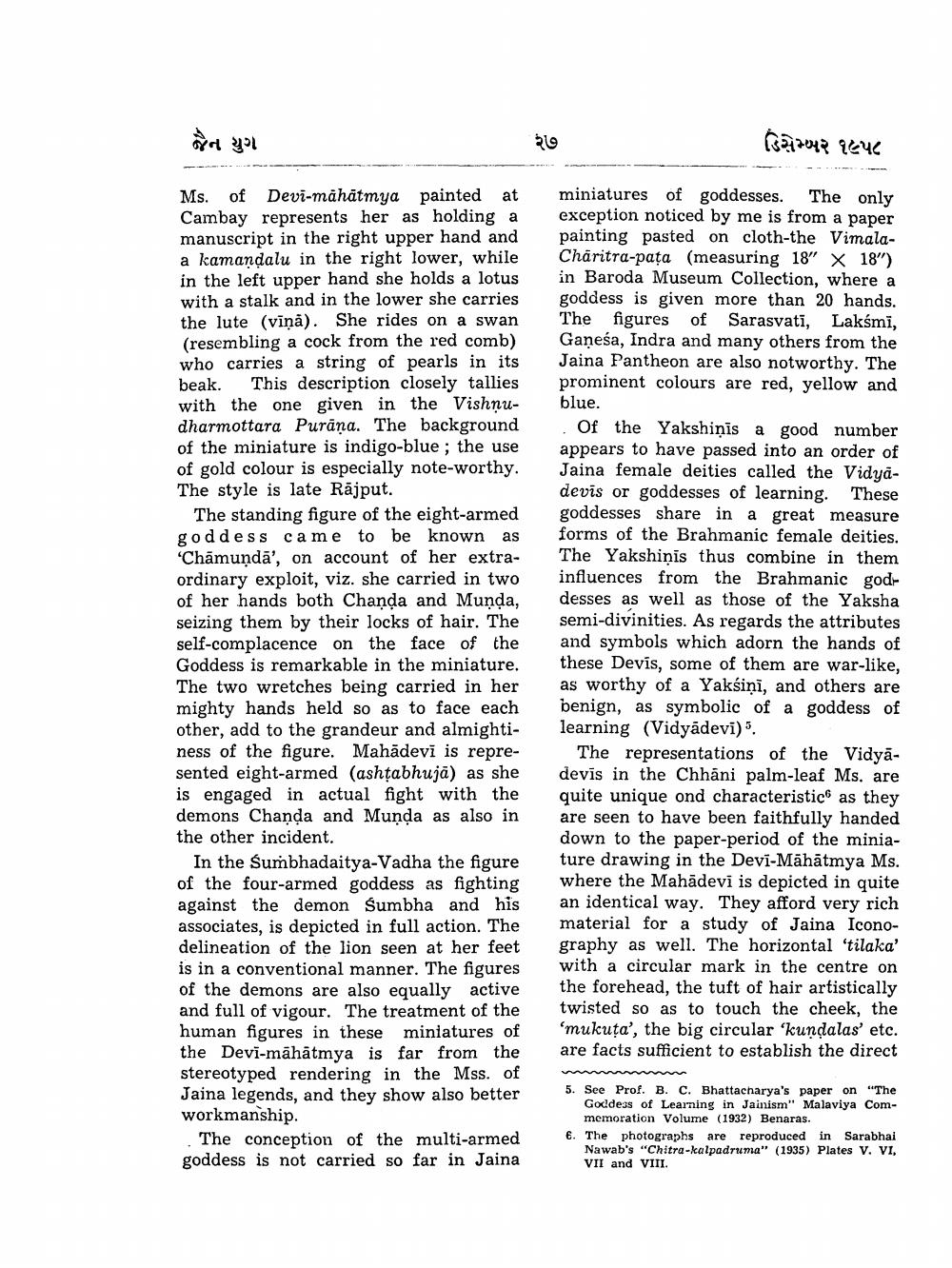________________
જેન યુગ
ડિસેમ્બર ૧૯૫૮
Ms. of Devi-mahatmya painted at Cambay represents her as holding a manuscript in the right upper hand and a kamandalu in the right lower, while in the left upper hand she holds a lotus with a stalk and in the lower she carries the lute (vīņā). She rides on a swan (resembling a cock from the red comb) who carries a string of pearls in its beak. This description closely tallies with the one given in the Vishnudharmottara Purāņa. The background of the miniature is indigo-blue; the use of gold colour is especially note-worthy. The style is late Rājput.
The standing figure of the eight-armed goddess came to be known as 'Chāmundā', on account of her extraordinary exploit, viz. she carried in two of her hands both Chanda and Munda, seizing them by their locks of hair. The self-complacence on the face of the Goddess is remarkable in the miniature. The two wretches being carried in her mighty hands held so as to face each other, add to the grandeur and almightiness of the figure. Mahādevi is represented eight-armed (ashtabhujā) as she is engaged in actual fight with the demons Chanda and Munda as also in the other incident.
In the Sumbhadaitya-Vadha the figure of the four-armed goddess as fighting against the demon Sumbha and his associates, is depicted in full action. The delineation of the lion seen at her feet is in a conventional manner. The figures of the demons are also equally active and full of vigour. The treatment of the human figures in these miniatures of the Devi-māhātmya is far from the stereotyped rendering in the Mss. of Jaina legends, and they show also better workmanship.
The conception of the multi-armed goddess is not carried so far in Jaina
miniatures of goddesses. The only exception noticed by me is from a paper painting pasted on cloth-the VimalaCharitra-pata (measuring 18" X 18'') in Baroda Museum Collection, where a goddess is given more than 20 hands. The figures of Sarasvati, Laksmī, Ganesa, Indra and many others from the Jaina Pantheon are also notworthy. The prominent colours are red, yellow and blue.
Of the Yakshiņis a good number appears to have passed into an order of Jaina female deities called the Vidyadevis or goddesses of learning. These goddesses share in a great measure forms of the Brahmanic female deities. The Yakshinis thus combine in them influences from the Brahmanic goddesses as well as those of the Yaksha semi-divinities. As regards the attributes and symbols which adorn the hands of these Devis, some of them are war-like, as worthy of a Yakšiņi, and others are benign, as symbolic of a goddess of learning (Vidyādevi)
The representations of the Vidyadevis in the Chhāni palm-leaf Ms. are quite unique ond characteristice as they are seen to have been faithfully handed down to the paper-period of the miniature drawing in the Devi-Māhātmya Ms. where the Mahādevi is depicted in quite an identical way. They afford very rich material for a study of Jaina Iconography as well. The horizontal 'tilaka' with a circular mark in the centre on the forehead, the tuft of hair artistically twisted so as to touch the cheek, the 'mukuta', the big circular 'kundalas' etc. are facts sufficient to establish the direct
5. See Prof. B. C. Bhattacharya's paper on "The
Goddess of Learning in Jainism" Malaviya Com
memoration Volume (1932) Benaras. 6. The photographs are reproduced in Sarabhai
Nawab's "Chitra-Kalpadruma" (1935) Plates V. VI, VII and VIII.




